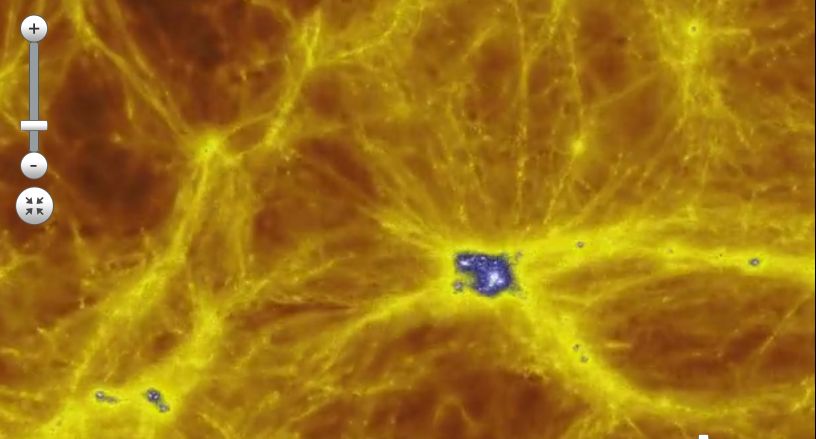Carnegie Mellon Researchers Build Time MachineThat Allows Visual Exploration of Space and Time
Byron SpiceThursday, April 21, 2011Print this page.

Time-lapse GigaPans Provide New Way To Access Big Data
PITTSBURGH-Researchers at Carnegie Mellon University's Robotics Institute have leveraged the latest browser technology to create GigaPan Time Machine, a system that enables viewers to explore gigapixel-scale, high-resolution videos and image sequences by panning or zooming in and out of the images while simultaneously moving back and forth through time.
Viewers, for instance, can use the system to focus in on the details of a booth within a panorama of a carnival midway, but also reverse time to see how the booth was constructed. Or they can watch a group of plants sprout, grow and flower, shifting perspective to watch some plants move wildly as they grow while others get eaten by caterpillars. Or, they can view a computer simulation of the early universe, watching as gravity works across 600 million light-years to condense matter into filaments and finally into stars that can be seen by zooming in for a close up.
"With GigaPan Time Machine, you can simultaneously explore space and time at extremely high resolutions," said Illah Nourbakhsh, associate professor of robotics and head of the CREATE Lab. "Science has always been about narrowing your point of view - selecting a particular experiment or observation that you think might provide insight. But this system enables what we call exhaustive science, capturing huge amounts of data that can then be explored in amazing ways."
The system is an extension of the GigaPan technology developed by the CREATE Lab and NASA, which can capture a mosaic of hundreds or thousands of digital pictures and stitch those frames into a panorama that be interactively explored via computer. To extend GigaPan into the time dimension, image mosaics are repeatedly captured at set intervals, and then stitched across both space and time to create a video in which each frame can be hundreds of millions, or even billions of pixels.
An enabling technology for time-lapse GigaPans is a feature of the HTML5 language that has been incorporated into such browsers as Google's Chrome and Apple's Safari. HTML5, the latest revision of the HyperText Markup Language (HTML) standard that is at the core of the Internet, makes browsers capable of presenting video content without use of plug-ins such as Adobe Flash or Quicktime.
Using HTML5, CREATE Lab computer scientists Randy Sargent, Chris Bartley and Paul Dille developed algorithms and software architecture that make it possible to shift seamlessly from one video portion to another as viewers zoom in and out of Time Machine imagery. To keep bandwidth manageable, the GigaPan site streams only those video fragments that pertain to the segment and/or time frame being viewed.
"We were crashing the browsers early on," Sargent recalled. "We're really pushing the browser technology to the limits."
Guidelines on how individuals can capture time-lapse images using GigaPan cameras are included on the site created for hosting the new imagery's large data files, http://timemachine.gigapan.org. Sargent explained the CREATE Lab is eager to work with people who want to capture Time Machine imagery with GigaPan, or use the visualization technology for other applications.
Once a Time Machine GigaPan has been created, viewers can annotate and save their explorations of it in the form of video "Time Warps."
Though the time-lapse mode is an extension of the original GigaPan concept, scientists already are applying the visualization techniques to other types of Big Data. Carnegie Mellon's Bruce and Astrid McWilliams Center for Cosmology, for instance, has used it to visualize a simulation of the early universe performed at the Pittsburgh Supercomputing Center by Tiziana Di Matteo, associate professor of physics.
"Simulations are a huge bunch of numbers, ugly numbers," Di Matteo said. "Visualizing even a portion of a simulation requires a huge amount of computing itself." Visualization of these large data sets is crucial to the science, however. "Discoveries often come from just looking at it," she explained.
Rupert Croft, associate professor of physics, said cosmological simulations are so massive that only a segment can be visualized at a time using usual techniques. Yet whatever is happening within that segment is being affected by forces elsewhere in the simulation that cannot be readily accessed. By converting the entire simulation into a time-lapse GigaPan, however, Croft and his Ph.D. student, Yu Feng, were able to create an image that provided both the big picture of what was happening in the early universe and the ability to look in detail at any region of interest.
Using a conventional GigaPan camera, Janet Steven, an assistant professor of biology at Sweet Briar College in Virginia, has created time-lapse imagery of rapid-growing brassicas, known as Wisconsin Fast Plants. "This is such an incredible tool for plant biology," she said. "It gives you the advantage of observing individual plants, groups of plants and parts of plants, all at once."
Steven, who has received GigaPan training through the Fine Outreach for Science program, said time-lapse photography has long been used in biology, but the GigaPan technology makes it possible to observe a number of plants in detail without having separate cameras for each plant. Even as one plant is studied in detail, it's possible to also see what neighboring plants are doing and how that might affect the subject plant, she added.
Steven said creating time-lapse GigaPans of entire landscapes could be a powerful tool for studying seasonal change in plants and ecosystems, an area of increasing interest for understanding climate change. Time-lapse GigaPan imagery of biological experiments also could be an educational tool, allowing students to make independent observations and develop their own hypotheses.
Google Inc. supported development of GigaPan Time Machine.
Nourbakhsh provides a guided tour of GigaPan Time Machine's features on YouTube.
Byron Spice | 412-268-9068 | bspice@cs.cmu.edu
